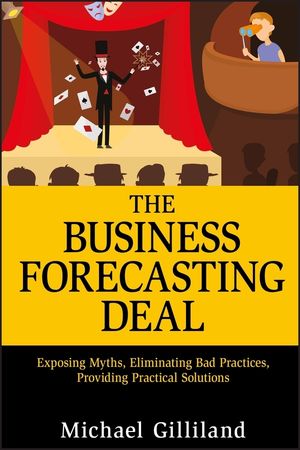The Business Forecasting Deal: Exposing Myths, Eliminating Bad Practices, Providing Practical SolutionsISBN: 978-0-470-57443-0
Hardcover
272 pages
June 2010
 This is a Print-on-Demand title. It will be printed specifically to fill your order. Please allow an additional 15-20 days delivery time. The book is not returnable.
|
||||||
Foreword—Tom Wallace xiii
Foreword—Anne G. Robinson xv
Acknowledgments xvii
Prologue 1
Chapter 1 Fundamental Issues in Business Forecasting 5
The Problem of Induction 5
The Realities of Business Forecasting 6
The Contest 7
What Is Demand? 10
Constrained Forecast 13
Demand Volatility 15
Inherent Volatility and Artificial Volatility 17
Evils of Volatility 19
Evaluating Forecast Performance 22
Embarking on Improvement 24
Notes 26
Chapter 2 Worst Practices in Business Forecasting: Part 1 29
Worst Practices in the Mechanics of Forecasting 30
Model “Overfitting” and “Pick-Best” Selection 32
Confusing Model Fit with Forecast Accuracy 41
Accuracy Expectations and Performance Goals 43
Failure to Use a Naïve Model or Assess Forecast Value Added 47
Forecasting Hierarchies 48
Outlier Handling 50
Notes 54
Chapter 3 Worst Practices in Business Forecasting: Part 2 55
Worst Practices in the Process and Practices of Forecasting 55
Politics of Forecasting 57
Blaming the Forecast 60
Adding Variation to Demand 61
Evangelical Forecasting 64
Overinvesting in the Forecasting Function 66
Forecasting Performance Measurement and Reporting 69
Forecasting Software Selection 74
Editorial Comment on Forecasting Practices 76
Notes 78
Chapter 4 Forecast Value Added Analysis 81
What Is Forecast Value Added? 82
The Naïve Forecast 83
Why Is FVA Important? 90
FVA Analysis: Step-by-Step 92
Further Application of FVA Analysis 101
Case Studies 102
Summary: The Lean Approach to Forecasting 107
Notes 108
Chapter 5 Forecasting without History.111
Typical New Product Forecasting Situations 111
New Product Forecasting by Structured Analogy 114
Organizational Realignment 120
Summary 131
Notes 132
Chapter 6 Alternative Approaches to the Problems of Business Forecasting.133
Statistical Approach 134
Collaborative Approach 136
Supply Chain Engineering Approach 142
Pruning Approach 145
Summary 149
Notes 150
Chapter 7 Implementing a Forecasting Solution 151
Why Do Forecasting Implementations Fail? 151
Preproject Assessment 153
Requesting Information or Proposals 154
Evaluating Software Vendors 155
Warning Signs of Failure 157
Notes 159
Chapter 8 Practical First Steps 161
Step 1: Recognize the Volatility versus Accuracy Relationship 161
Step 2: Determine Inherent and Artifi cial Volatility 165
Step 3: Understand What Accuracy Is Reasonable to Expect 166
Step 4: Use Forecast Value Added Analysis to Eliminate Wasted Efforts 167
Step 5: Utilize Meaningful Performance Metrics and Reporting 168
Step 6: Eliminate Worst Practices 169
Step 7: Consult Forecasting Resources 170
Notes 173
Chapter 9 What Management Must Know About Forecasting 175
Aphorism 1: Forecasting Is a Huge Waste of Management Time 175
Aphorism 2: Accuracy Is Determined More by the Nature of the Behavior Being Forecast than by the Specific Method Being Used to Forecast It 177
Aphorism 3: Organizational Policies and Politics Can Have a Significant Impact on Forecasting Effectiveness 179
Aphorism 4: You May Not Control the Accuracy Achieved, But You Can Control the Process Used and the Resources You Invest 180
Aphorism 5: The Surest Way to Get a Better Forecast Is to Make the Demand Forecastable 182
Aphorism 6: Minimize the Organization’s Reliance on Forecasting 183
Aphorism 7: Before Investing in a New System or Process, Put It to the Test 184
Notes 185
Epilogue 187
Glossary 189
Appendix Forecasting FAQs 193
Accuracy Expectations 193
Performance Benchmarks 196
Performance Measurement and Reporting 198
The Naïve Forecast 208
Forecast Value Added Analysis 211
Forecast Modeling 220
Politics and Practices of Forecasting 224
Demand Volatility 227
Forecasting Process 230
Judgment 237
Forecasting Organization 238
Low Volume/Intermittent Demand 239
New Product Forecasting 241
Forecasting Hierarchy 242
Software Selection 245
Index 247



